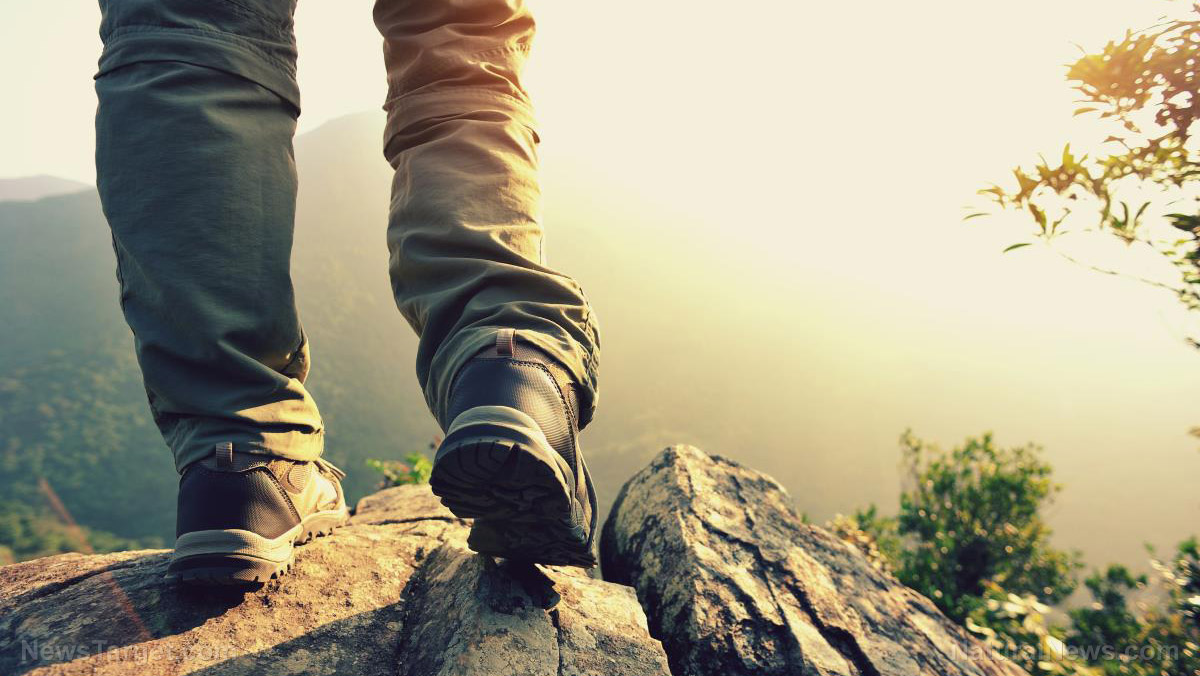How to keep your feet dry when hiking in wet weather
08/03/2018 / By Zoey Sky

When hiking, it’s easy to keep your torso and legs dry because you can simply put on a waterproof jacket or hiking pants. However, making sure your feet stay warm and dry is a much more serious matter. (h/t to OutsideOnline.com)
Thru-hiking, or through-hiking, refers to hiking a long-distance trail end-to-end. This is usually done within one hiking season, but if you’re unprepared, you can suffer from various hiking-related health concerns like wet feet, which can lead to trench foot.
A trench foot is a medical condition caused by prolonged or repeated exposure of the feet to damp, cold, and often unsanitary conditions.
Keeping your feet dry
Here are some tips on how to ensure that your feet stay as dry as possible during a hike.
- Skip the waterproof shoes – Even though waterproof shoes can protect your feet from the water, any moisture that seeps in through the cuffs is still bad for your toes. Get a breathable pair of shoes instead so they won’t retain water and they can dry quickly. You can also combine wicking socks with breathable shoes, or you can opt for trail running shoes that will dry out overnight.
- Bring lots of wool socks – Pack several pairs of wool or wool wicking-blend socks. Once you get some sunshine after you’ve had to walk in the rain with wet socks, take off the wet pair and change into your spare socks immediately. Try to pack several pairs of socks and if a pair gets drenched, wring them out and put them in the pockets of your rain jacket so they’ll dry faster. If they’re not too wet, sleep with them inside your sleeping bag.
- Take micro breaks – Seize the chance to air out your feet whenever you can. They don’t have to dry out completely, but even short periods of fresh air spread out through a whole day will help. This will prevent your feet from rotting, and the breaks will give you chance to check for “itchy funk and hot spots,” which can turn into blisters because of the friction between your skin and wet socks.
- Always clean your feet before sleeping – Keep your feet clean and wash the dirt thoroughly. Check for dead skin daily, especially in between the toes. A tea tree oil cleanser can help minimize bacterial and fungal growth.
- Bring antibiotic foot cream and lubricant – Friction can make things worse if your feet and socks are wet, but this can be addressed with some natural lubricant. With blisters, your skin hardens and this can lead to other issues like “rubbing and chafing.” Prevent this by applying lube on your blisters. With wet feet, the chances of getting infections can increase because bacteria and fungus thrive in damp and dark areas. This can be resolved with some homemade ointment, which, unlike Neosporin, doesn’t have any side effects.
- Keep your shoes and socks dry – It sounds obvious, but some hikers can forget how important this tip is. Wring socks out and hang them to dry or keep them in your jacket while hiking. Body heat can also help speed up the drying process. Remove the insoles of your shoes and loosen the shoes when you’re sleeping so air flow is boosted and you can make the most of the drying potential.
Sponsored solution from the Health Ranger Store: The Big Berkey water filter removes almost 100% of all contaminants using only the power of gravity (no electricity needed, works completely off-grid). Widely consider the ultimate "survival" water filter, the Big Berkey is made of stainless steel and has been laboratory verified for high-efficiency removal of heavy metals by CWC Labs, with tests personally conducted by Mike Adams. Explore more here.
For thru-hikers, keeping your feet healthy during a hike is a big deal, especially in wet weather. To learn more about proper hiking gear and other prepping tips, visit Bugout.news.
Sources include:
Tagged Under: backpacking, boots, bug out, hike, hiking, hiking shoes, off grid, outdoor gear, preparedness, prepper, prepping, socks, survival, Survival Tips, survivalist, trek, trekking, trench foot




















